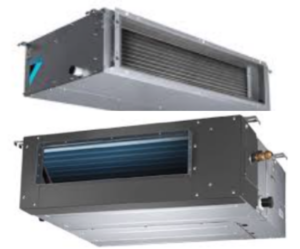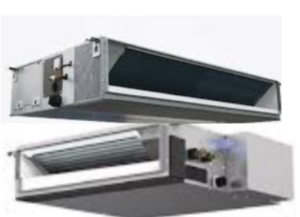With the rise in outdoor temperatures, it has become increasingly important to have a system that can provide efficient cooling and ventilation. One of the most popular types of air conditioners in the market is the ceiling concealed AC unit. These units are a great choice for those who want to keep their rooms cool without having a bulky unit taking up space in their living area. However, before installing a ceiling concealed AC unit, there are several factors that need to be taken into consideration. In this guide, we will discuss the installation process of a ceiling concealed AC unit, the benefits of having one, and some important considerations that you need to keep in mind before installation. Whether you are a homeowner, a business owner, or a contractor, this guide will provide you with all the information you need to know about ceiling concealed AC installation.
Ceiling concealed air conditioning (AC) systems are becoming increasingly popular in both residential and commercial settings. These systems offer a discreet and efficient solution for cooling or heating a space without compromising the aesthetics of the interior design.
The key feature of a ceiling concealed AC system is its ability to be hidden within the ceiling, making it virtually invisible to the occupants. The indoor unit is installed above the ceiling, and only the supply and return air grilles are visible. This seamless integration allows for a clean and unobtrusive look, perfect for spaces where visual appeal is a priority.
One of the major advantages of a ceiling concealed AC system is its ability to provide even airflow throughout the room. The supply air is distributed evenly from the ceiling, creating a comfortable environment with no noticeable drafts. This is particularly beneficial for spaces with high ceilings or open floor plans, where traditional wall-mounted units may struggle to provide consistent cooling or heating.
Another advantage of ceiling concealed AC systems is their quiet operation. Since the indoor unit is located above the ceiling, the noise generated during operation is significantly reduced. This makes them an excellent choice for bedrooms, offices, or any area where peace and quiet are essential.
Installation of a ceiling concealed AC system involves careful planning and coordination with an HVAC professional. The indoor unit is typically installed during the construction or renovation phase, as it requires access to the ceiling space. The unit is concealed within a dedicated enclosure, ensuring easy maintenance access when needed.
In terms of maintenance, ceiling concealed AC systems are designed to be low-maintenance and user-friendly. Regular filter cleaning or replacement is necessary to maintain optimal air quality and system efficiency. However, with proper care and periodic servicing, these systems can provide reliable cooling and heating for many years.
Benefits of ceiling concealed AC system
Ceiling concealed AC systems offer a plethora of benefits that make them a popular choice for both residential and commercial spaces. These systems are designed to be discreetly installed above the ceiling, allowing for a seamless integration with the overall aesthetics of the room. Here are some key benefits that make ceiling concealed AC systems a worthwhile investment:
1. Space-saving: One of the major advantages of ceiling concealed AC systems is that they do not occupy any floor or wall space. As the unit is concealed above the ceiling, it frees up valuable square footage that can be utilized for other purposes. This is particularly beneficial for smaller spaces where every inch matters.
2. Enhanced aesthetics: Unlike traditional AC units that can be bulky and visually disruptive, ceiling concealed AC systems blend seamlessly into the ceiling. The only visible part is the discreetly placed air diffuser, which can be customized to match the room’s decor. This allows for a clean and uncluttered look, enhancing the overall aesthetics of the space.
3. Improved air distribution: Ceiling concealed AC systems utilize innovative ducting technology to distribute conditioned air evenly throughout the room. The strategically placed air vents ensure that the cool or warm air reaches every corner of the space, providing consistent and comfortable airflow. This eliminates hot or cold spots and creates a more pleasant indoor environment.
4. Reduced noise levels: As the main unit of the ceiling concealed AC system is hidden above the ceiling, the noise generated by the compressor and fan is significantly reduced. This ensures a quieter operation, allowing occupants to enjoy a peaceful and undisturbed atmosphere. It is especially beneficial for bedrooms, living rooms, or any area where noise levels need to be kept to a minimum.
5. Energy efficiency: Ceiling concealed AC systems are designed to be highly energy-efficient. With advanced features like variable speed compressors, programmable timers, and intelligent temperature control, these systems can optimize energy usage and reduce utility costs. Additionally, the concealed design helps in better insulation, preventing any loss of conditioned air and improving overall energy efficiency.
Factors to consider before installing a ceiling concealed AC system
Before embarking on the installation of a ceiling concealed AC system, there are several factors that need to be carefully considered. These factors will not only ensure the optimal functioning of the system but also guarantee the satisfaction of the occupants.
First and foremost, the size and layout of the space need to be taken into account. The ceiling concealed AC system requires adequate space for installation, including sufficient ceiling height and clearance. Assessing the dimensions of the area will help determine if the system is feasible and if any modifications need to be made.
Additionally, considering the specific cooling requirements of the space is essential. Factors such as the number of occupants, the heat generated by equipment or appliances, and the overall climate conditions should be evaluated. This information will aid in selecting the appropriate capacity and configuration of the ceiling concealed AC system to ensure efficient and effective cooling.
Moreover, the noise level produced by the AC system should be considered. As the unit is installed above the ceiling, it is crucial to choose a system that operates quietly to avoid any disturbance or discomfort to the occupants. Manufacturers often provide specifications regarding the noise level of their units, allowing for informed decision-making.
Another critical factor to contemplate is the maintenance and accessibility of the system. Regular maintenance is essential for the longevity and optimal performance of any AC system. However, with a ceiling concealed AC system, accessibility can be a challenge. Ensuring that proper provisions are made for maintenance and servicing, such as easily accessible service panels or removable grilles, will simplify the process and prevent any potential disruptions.
Lastly, it is crucial to consider the budget and energy efficiency of the system. Investing in a ceiling concealed AC system may require a higher upfront cost compared to other options. However, the long-term benefits in terms of energy savings and improved aesthetics may outweigh the initial expenses. Assessing the overall budget and exploring energy-efficient models will help strike a balance between cost-effectiveness and performance.
By carefully considering these factors before installing a ceiling concealed AC system, you can ensure a seamless and efficient cooling solution for your space. Taking the time to evaluate your requirements and make informed decisions will result in a comfortable environment for occupants and long-term satisfaction with your AC system.
Step by step guide to the installation process
Installing a ceiling concealed air conditioning (AC) system may seem like a daunting task, but with the right knowledge and preparation, it can be a smooth process. In this step-by-step guide, we will walk you through the installation process, ensuring that you have everything you need to successfully install your ceiling concealed AC unit.
Step 1: Planning and Preparation
Before you begin the installation, it’s crucial to carefully plan the layout of the system. Consider factors such as the size of the room, the desired cooling capacity, and the optimal location for the unit. Additionally, ensure that you have all the necessary tools and equipment ready, including ductwork, electrical wiring, and mounting brackets.
Step 2: Mounting the Indoor Unit
Start by selecting the ideal location for the indoor unit, usually on the ceiling. Make sure the area is clear of obstructions and can support the weight of the unit. Securely mount the unit using the provided brackets, ensuring it is level and stable.
Step 3: Electrical and Refrigerant Connections
Next, connect the necessary electrical wiring from the unit to the main power source. It is essential to follow safety guidelines and, if unsure, consult with a professional electrician. Additionally, connect the refrigerant lines from the outdoor unit to the indoor unit, ensuring proper insulation and sealing to prevent any leaks.
Step 4: Ductwork Installation
Carefully install the necessary ductwork to distribute the conditioned air throughout the room. This may involve cutting holes in the ceiling, walls, or floors, depending on the layout of the space. Ensure that the ducts are properly sealed to prevent any air leakage, maximizing the system’s efficiency.
Step 5: Outdoor Unit Installation
Place the outdoor unit in a suitable location outside the building, away from direct sunlight or obstructions. Ensure that it is securely mounted on a stable surface and that the necessary electrical and refrigerant connections are made following the manufacturer’s guidelines.
Step 6: Testing and Commissioning
Once the installation is complete, it is crucial to thoroughly test the system to ensure proper functionality. Check for any leaks, test the airflow and temperature control, and verify that all electrical connections are secure. If any issues arise, address them promptly to avoid future complications.
Step 7: Regular Maintenance
To ensure the longevity and efficiency of your ceiling concealed AC system, regular maintenance is essential. This includes cleaning or replacing filters, inspecting and cleaning the ductwork, and scheduling professional servicing at recommended intervals.
With this step-by-step guide, you can successfully install a ceiling concealed AC unit, providing efficient cooling while maintaining an aesthetically pleasing space. However, if you are unsure or lack the necessary expertise, it is always recommended to consult with a professional HVAC technician for a seamless installation process.


